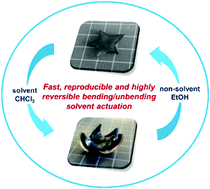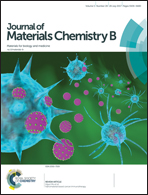Bilayer solvent and vapor-triggered actuators made of cross-linked polymer architectures via Diels–Alder pathways†
Abstract
A simple and straightforward approach to produce solvent and vapor-based actuating materials is developed in this work. These actuators are based on rigidity gradients created in bilayer architectures made of reversibly cross-linked poly(ε-caprolactone) (PCL) networks into which functional nanofillers, i.e. multi-walled carbon nanotubes (MWCNTs), are incorporated using simple processing techniques. A key element of the bilayer functionality lies in, by taking advantage of thermo-reversible Diels–Alder reactions (between furfuryl and maleimide moieties), ensuring good adhesion between the layers. Thereby, the produced material instantaneously swells in an anisotropic way due to the rigidity gradient, resulting in reproducible bending actuations. Besides, it is shown that the percolating network of electrically conductive MWCNTs offers the possibility of implementing these bilayers as solvent detector sensors. This opens the door to the development of multi-responsive devices with tunable actuating behaviors and potential application in the robotics field as self-deployable structures in different environments (water, organic solvents, etc.).


 Please wait while we load your content...
Please wait while we load your content...